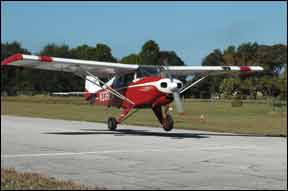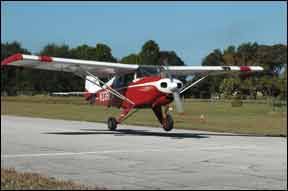No matter how smooth and enjoyable the flight, your passengers always will remember the landing. Anything other than a single, bounce-free touchdown is ripe for comment and, if your passengers also are pilots, ridicule. While a good landing is a combination of many factors, the last chance you have to affect its outcome is in the flare.

288
Whether you’re flaring too high above the runway or too low, at too high an airspeed or too enthusiastically, there’s usually a fix for what ails your landings. A lot of it can come down to how you transition from approaching the runway with the nose down to the ideal nose-up, power-off attitude, inches above the runway. It’s not that hard.
Airspeed
Coming into the flare at too high or too low an airspeed is a recipe for failure. If you’ve been flying the same airplane for very long, you’ve probably gone up, perhaps with a CFI, to explore its low-speed handling. From that exercise, you should know how it handles in that regime.
You also should know at what speed the airplane stalls (Hint: It’s color-coded on the airspeed indicator.) In non-gusty conditions, flying the final approach at anything above 1.3 times the landing configuration stalling speed (I prefer 1.2…) guarantees floating a bit after you begin the flare. Since, by regulation, no U.S.-certificated single-engine airplane has a landing-configuration stalling speed (VSO) greater than 61 knots, coming across the numbers at, say, 80 knots, means you should have a long runway and be patient. If it takes a while for your airplane to decelerate in the flare, you find yourself flaring too early or the airplane balloons, you’re likely too fast.
The fix for this can be simple: Slow down! Presuming an airplane with a 55-knot VSO, you should be at no more than 71.5 knots “over the fence,” i.e., as you approach the runway threshold. Slightly slower, say 1.2 times VSO, or 66 knots for an airplane stalling at 55 knots in the landing configuration might be better, especially for an aerodynamically clean airplane, or one that’s very light.
Smoothly, Deliberately
Another cause of ballooning in the flare can be too much enthusiasm. Ideally, the flare itself—a maneuver consisting of increasing back pressure on the pitch control to transition from a level or nose-low approach to the desired nose-up touchdown attitude—is one smooth, fluid motion. The speed with which we add back pressure on the pitch control is determined by airspeed, our height above the runway and sink rate.
As we touched on above, if you’re ballooning, speed likely is the issue. Either the airplane is too fast or you’re flaring too quickly. Likewise, if your flare consists of incrementally pitching up the nose, stopping to see what happens and then pitching up some more, you’re likely doing it too quickly, also. Slow down, and strive for a smooth, continuous, fluid motion. Some fine-tuning of the flare is expected as it progresses, so don’t worry if you need to stop pitching up midway into it to prevent ballooning.
One other key to the flare is understanding the visual cues you’ll be receiving. When the nose is pitched up, it might be hard to gauge where the runway is. But your peripheral vision will serve you well in setting and maintaining the proper attitude. Ultimately, you’ll gain confidence as you practice, and your flares will be a single, fluid movement during which the outcome is never in doubt.
Getting The Nose Up
This article is mainly focused on tricycle-gear airplanes, although flaring a taildragger is pretty much the same. When performing a wheel landing with a taildragger, however, you may not want the nose to get too high. Meanwhile, a three-point landing in a taildragger will be pretty much the same as landing a trike on its mains. A three-point landing with a tricycle-gear airplane is a no-no.
Why? Because you risk damaging the relatively fragile nosewheel if it’s the first part of the airplane to come in contact with the runway. In the worst-case scenario, landing nosewheel-first can risk a prop strike. Lesser and more-likely outcomes include damage to the airplane’s firewall and fuselage, in addition to the nosewheel itself. Yes, these are extreme cases, but landing on the nosewheel also has been known to cause complete loss of directional control, runway excursions, and more. So, getting the nose up is one of the goals of flaring.
To do that, of course, we must pitch the airplane from the nose-down attitude with which we’re descending to the runway, through level and into a nose-high position. Of course, anytime we pitch the nose up, the airplane may want to climb. That’s the textbook case of ballooning in the flare. To do that without ballooning means successfully managing airspeed and the rate with which we add back pressure on the pitch control.
Finally, once we get the nose up—and it doesn’t have to be much, although higher usually is better—we need to keep it there. The challenge here is that, as we decelerate, the elevators/stabilator lose effectiveness. To compensate, we need additional back pressure on the pitch control. Depending on the airplane and how it’s loaded, we may find ourselves with a full-aft pitch control as the mains touch down. There’s little wrong with that.
Stalling
One way to think about performing a normal flare and landing is to fly the airplane to just above the runway then stall it. Ideally, the airplane should be completely finished with flying as it touches down. You’ve done power-off stalls at altitude; here, we’re just doing them a bit lower.
Of course, stalling too early in the flare means a hard landing. You’ve pitch up too high, pitched up too quickly or some combination of the two. Flying too slow an approach can also result in a stall, but you’re supposed to compensate for low airspeed by not flaring as enthusiastically as you might otherwise.
Extreme Cases
Up to now, we’ve basically been exploring normal approaches to adequate paved runways on calm days. But not all of our landings will be idyllic—crosswinds, gusts, short fields and even mechanical problems can dictate modifying these procedures.
Often, crosswinds and gusts come in the same package. Especially with gusty conditions, you’re justified in carrying extra speed and perhaps some power into the flare. How much extra speed? The rule of thumb is to add one-half the gust value to your final approach speed. So, if we’re dealing with a 10-knot gust and our normal, over-the-fence speed is 70 knots, maintain 75 knots. But beware of having too much of a good thing: By the time we get to 1.5 VSO as an approach speed by adding gust compensation, we should be re-thinking our plan to use this runway and consider going somewhere else.
Carrying a little bit of power into the flare is another way to compensate for gusts. A steady-state crosswind, on the other hand, shouldn’t cause us to modify our flare, except we may also want to carry some power to slow down the deceleration rate and allow us to get the upwind main wheel on the ground first, then the other, before reducing power to idle and lowering the nosewheel.
Short fields present a different challenge; we may want to be slower than normal. If we do, then we’ll need to pitch up the nose more enthusiastically, since we won’t have as much speed to bleed off. Also, we don’t want to float down the already-too-short runway.
Practice Makes Perfect
As with so many things we do in an airplane, one of the keys to nailing the landing flare is to do it smoothly and in a coordinated fashion. Directional control must be maintained throughout, power reduced, the nose pitched up and the wings kept level, or nearly so.
At first, we may want to use the incremental approach—add some back pressure, wait for the reaction, rinse/repeat. As we get more comfortable and experienced, our flares also will become smoother and more predictable, and lead to the kinds of arrivals our passengers—even other pilots—won’t remark about, except to say how they wish they could pull them off as well.




